by Heather Plett | Aug 1, 2013 | Uncategorized
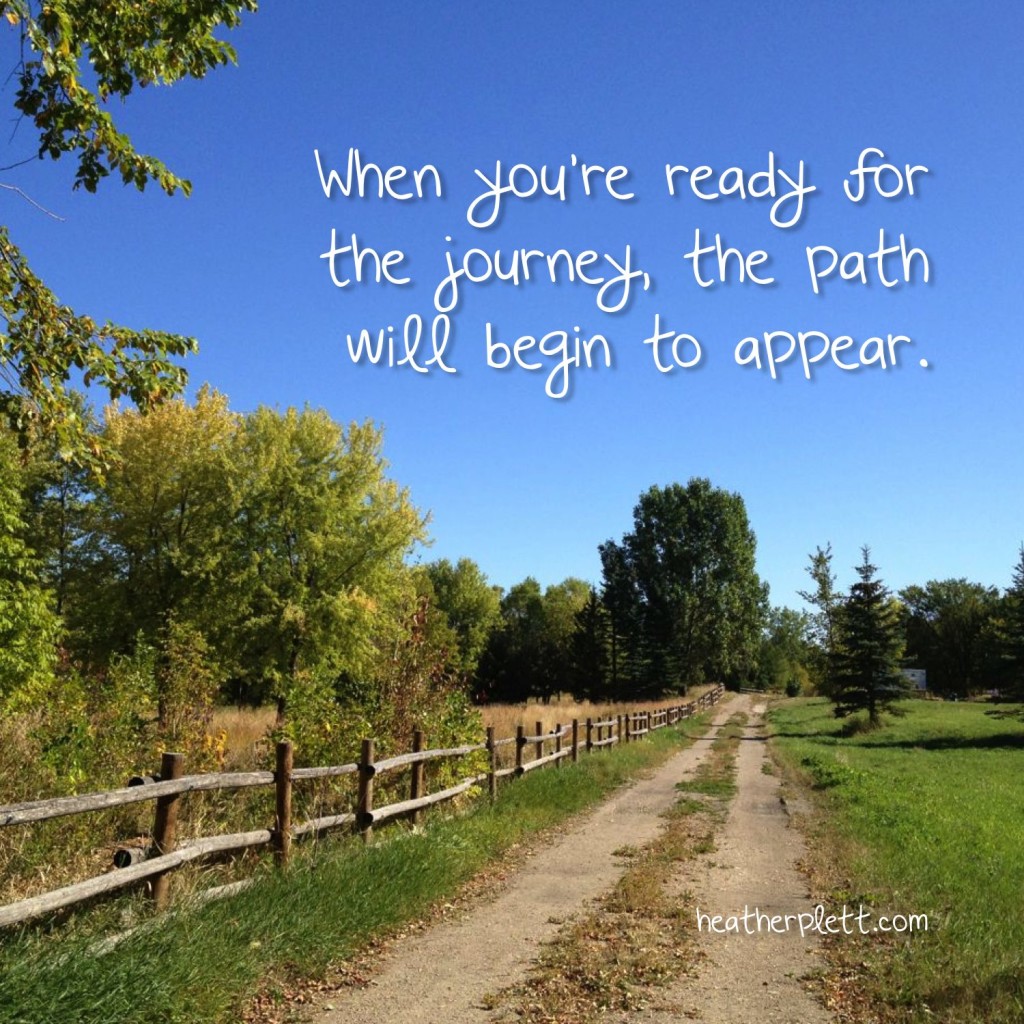 What do a human rights lawyer in Zimbabwe, a psychologist who’s a wealth management specialist in Los Angeles, a former pastor training to be an art therapist in rural Manitoba, and a manager in an international tech company in Chicago have in common?
What do a human rights lawyer in Zimbabwe, a psychologist who’s a wealth management specialist in Los Angeles, a former pastor training to be an art therapist in rural Manitoba, and a manager in an international tech company in Chicago have in common?
They’ve all gained something from my coaching.
What else do they have in common? They have a longing to make a difference in the world and to lead from a place of greater authenticity, deeper spirituality and more courage.
All three of these people (and all of my other clients) already had a great deal of wisdom long before they came into contact with me. They are lifelong learners, committed to doing good work in the world. They are strong, compassionate, and they have a lot of vision for how to make the world a better place. So… if they already had all these things, what did they need from me? They needed someone to ask the right questions and create the right environment to help them find their deeper truths, their authentic longings, and the next steps in their journeys. They needed clarity and support, and they needed someone who would challenge them to be the best versions of themselves.
That’s what I do for my clients – ask the right questions, create a safe environment, encourage them, and then nudge them into the places their hearts are already longing to take them.
My coaching work is not about creating something out of nothing – it’s about excavating the stories you already carry, the wisdom you might have buried under your own self-doubts, and the longing that has been waiting for you to give it space. It’s also about moving the blocks out of the way and challenging the stories that keep you small.
The deepening journey…
In Falling Upward, Richard Rohr talks about the deepening journey of the second half of life, when we leave the comforts of dualistic thinking (our black and white, rules-based world) and self-absorption, and move further into ambiguity, trust, and concern for the common good. This is a journey to our True Self, and it does not come without a struggle.
My coaching is about that journey to the True Self. I won’t take the struggle away, or make it easier to get to your True Self (because there is much to learn in the struggle and taking it away would not do you any favours), I’ll simply help you be more present, have more clarity, and take a more confident step onto the path.
In that journey to our True Self, you’ll begin to find yourself emerging into one of the leaders the world is longing for. I’ll help you understand what it means for you to be a leader.
“A leader is anyone willing to help, anyone who sees something that needs to change and takes the first steps to influence that situation.” – Margaret Wheatley
When I say that I coach leaders, it means that I coach anyone willing to help. Whether you lead from a place at the boardroom table, the kitchen table, or the garden bench, the world needs your willingness to help. You simply need to show up and hold your place in the circle.
If you are willing to help, but you’re afraid to call yourself a leader, I’d be happy to work with you.
Back to school…
September is back to school time, when we put away the flip-flops, clean out the backpacks, sharpen the pencils, and get ready for another year of learning, growth, and challenge. It’s a good time of year to commit to the new things that want to emerge in our lives. It’s a good time to consider what our next journey will look like.
September is also the time of harvest, when we gather the good things from our gardens, enjoy the feasts of Thanksgiving, and freeze and preserve what we’ll need for the long winter months.
Even if you’re not going back to school, September is a good month to invest in your own growth and learning, gather the fruits of your personal harvest, and contemplate the next steps in your journey. It’s a good time to invest in coaching for your own growth.
Invest in yourself…
This September, consider investing in yourself by working with me as your coach. To make that a little easier, I’m having a “back to school” sale.
Book a one-time coaching session for only $75. That’s 25% off the regular price.
Even better (because deep work takes time)… Book three sessions for $195. We’ll get really juicy in three sessions and I guarantee you’ll have a few a-ha moments in that time.
OR… sign up for the Fall session of Lead with Your Wild Heart, and take the journey in community with other learners. You’ll get the extra benefit of sharing in the stories of others who are also deepening in their leadership and self-discovery.
Back to School Sale ends August 23, 2013.
Note: I incorporate elements of a gift economy into my business model, and so I’ve created something called Karma Coaching. If you are doing important work in the world and believe that you would benefit from my coaching, I don’t want to let limited financial resources get in the way. Find out how you can benefit from the gift of my coaching, or participate in the gift economy by supporting other world-changers who want coaching.
by Heather Plett | Jun 28, 2013 | Uncategorized
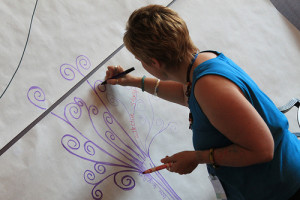
I’m not very good at being an expert.
As I’ve been building this business around writing, coaching, and teaching, I continue to have some discomfort around people’s expectation that I become The Expert. I get emails from people who want advice on how to be a better leader/teacher/artist. My students ask me for advice on how to be a better writer/communicator/speaker. Underneath their questions, I hear the unspoken words “you’re The Expert and I’m the amateur – please give me the formula for how to be successful in this.”
Each time I hear the unspoken words, I chafe a little. I don’t want to be The Expert. I don’t want to tell them how to do it. I don’t mind sharing what I’ve learned, or telling them a story from my own experience (that’s why I teach, after all), but mostly I want to help them find their own wisdom. And I want to tell them that “you’ll only get better if you keep practicing.” And “why don’t you find a community of people who are doing this work who can support you in your quest for understanding?”
People get tired of hearing those answers from me. They simply want The Answer. They want to be handed the key that will open the door into The Land of Success. And then, when The Land of Success doesn’t look quite like they expected, they want to be able to say “it’s not MY fault. I was simply following the advice of The Expert.” That’s the way our culture has trained us to think – experts have the answer, banks control the money, teachers have the wisdom, lawyers and judges and police officers control justice, doctors know about health, etc.
It used to be the same when I was in a leadership position that attached the word “Director” to my name. Surely someone who’s a Director should be comfortable with being The Expert and The Boss, right? Wrong. Even back then, I would answer my employees questions with “What do YOU think is the right course of action?” and “Where do YOU think we should look for better solutions to these challenges?” and “What do YOU think our vision should be?” Occasionally my employees got rather upset with me. One of them, who loved to refer to me as The Boss (especially when he knew it made me uncomfortable) would remind me on an annual basis “You’re getting paid the big bucks – it’s YOUR job to tell us what the vision is and it’s our job to carry out that vision.”
Umpteen leadership books, coaches, and motivational speakers told me exactly what he’d said. “Leaders are supposed to hold the vision.” “You shouldn’t be afraid to call yourself The Expert. You’ve earned this – claim it.” And so I began to doubt my own self-confidence. Maybe I SHOULD be The Director who spells out The Vision for my team. Maybe I SHOULD be The Expert who tells her students exactly how things should be done. Maybe I shouldn’t shy away from being seen as The One Who Holds The Answers/Vision/Knowledge/Truth.
And so I tried on that hat a few times. I tried to act more confident, show off my knowledge more, and let people refer to me as The Expert. Own it, claim it, wear the hat – that’s what the motivational speakers said. But the hat didn’t fit. And it made my head itchy.
So I went back to asking questions, sharing stories, and helping people find their own wisdom. THAT hat fit me perfectly.
That’s why, when I discovered The Circle Way a dozen years ago, and then The Art of Hosting three years ago, I knew I had found my home.
In a circle, there are no experts – instead there are stories, questions, tears, longings, dreams – and a bunch of equal people who trust their own wisdom and each others’.
As a host, there is no need to be an Expert or The Keeper Of The Truth – instead there is the need to create a container where people can experience safety and trust, and where ideas and questions are more valuable than Visions. There is the need to help people find their own wisdom. And there is the need to be attuned to the energy in the room and the place where the group wants to go.
The more I learned, the more I became convinced that this is the kind of leaders and teachers we need in the world. The way I’d always felt compelled to lead was not because of my lack of confidence, it was because of my intuitive sense that something different was needed. Finally learning to trust that intuitive sense was one of the best things I’ve ever done.
That’s why I am delighted that, after several years of dreaming of it, I’m helping to bring The Art of Hosting and Harvesting Conversations That Matter to my home province. We’re doing a one-day “taster” workshop in July, and then we’ll host a three-day version in October.
Join us! There will be a comfortable place in the circle for you!
by Heather Plett | Feb 6, 2013 | change, circle, Creativity, Leadership, women
I have the great privilege these days of co-hosting a women’s leadership program that meets every second week in a small town an hour and a half from the city where I live. There are so many things about this that I love, including the fact that I have a regular reason to drive out into the country and see the wide open prairies and the wild, alluring woods. With no parents left to visit, I don’t get out to my rural roots often enough to suit me.
On the drive out there yesterday, we had a rare and wonderful sighting of a lynx as it dashed across the road and ran off into the snowy woods. It felt like a moment of blessing.
Yesterday’s session focused on facilitating change. The best change process I know of is Theory U, a process I was first immersed in at ALIA Summer Institute and that I’ve been a dedicated student of since.
I introduced the idea of a Change Lab, where-in we would walk through the U process by casting ourselves in the role of community leaders who recognize the need for change in how the community is organized.
I started out by sharing the story of Baba Yaga’s House in Paris, France, a home created for aging feminists by a circle of women who realized that none of the available models for seniors’ housing fit with their values or expectations of how they wanted to live. (I encourage you to listen to the podcast at the link above.) “Imagine we are these women,” I said. “We are faced with an established community model we know doesn’t work for us, and yet we haven’t found a new model that we’re comfortable with.”
From there I moved on to an explanation of Theory U, a method for co-creating social change. Instead of trying to find a direct route from challenge to solution – the way some of the more linear models do, with brainstorming, strategic planning, etc. – Theory U takes us on a deep dive into the unknown. Instead of trying to direct change, we host what is wanting to be born. Instead of trying to control, we let go and let come. Instead of expecting the future to look like the past with just a few tweaks, we invite a new future to spiral up out of the brokenness of the past.
 In Theory U there are three main parts – sensing, presencing and realizing. In the sensing phase, we are invited to use all of our senses to witness what is present. We are invited to suspend our judgements, opinions, assumptions and mental models, and to use our eyes and ears and the feeling of our bodies to sense into whatever the context is. We host conversations, we ask good questions, we listen deeply, we watch with full attention, and we notice how our bodies feel.
In Theory U there are three main parts – sensing, presencing and realizing. In the sensing phase, we are invited to use all of our senses to witness what is present. We are invited to suspend our judgements, opinions, assumptions and mental models, and to use our eyes and ears and the feeling of our bodies to sense into whatever the context is. We host conversations, we ask good questions, we listen deeply, we watch with full attention, and we notice how our bodies feel.
In the presencing phase, we are invited into the inner work of grounding ourselves in our bodies and paying attention to what is emerging. We listen into the space and learn from the future as it emerges, letting go of our expertise and experience. Rather than moving directly into problem solving or brainstorming, we take time for retreat and reflection. The best place for presencing is outside in nature where we ground ourselves in the earth and lean into the trees.
The third phase is Realizing. In this phase – on the upward movement out of the U – we “let come” what wants to emerge. We bring insights, sparks of inspiration, and crystals of ideas into prototypes. We move into action quickly and create small projects that can move the vision forward.
When I introduced Theory U to a women’s circle in Ontario last year, someone pointed out that I’d just drawn a woman’s breast. She said it with laughter, but when we started to unpack that, we realize that there was resonant truth to what she witnessed. This process definitely has a feminine aspect to it (as is laid out in this article by Arawana Hayashi) and it relates well to an infant suckling at the source of his/her life. It’s about going back to Source, it’s about seeking nurturing and rebirth, and it’s about the kind of rest and retreat that a mother must seek every few hours when an infant needs to suckle. It’s about being innocent, vulnerable, uneducated, without judgement, and open to a new future, just like that tiny baby. Since that first observation, I’ve brought up the idea every time I introduce it, and it always opens up interesting dialogue.
Once I had introduced the Theory, it was time to move into practice. To start with, I did one of my favourite things to do in workshops – I dumped a pile of garbage on the floor (things I’d gathered from my household recycling bin). “This,” I said, “represents the chaos and brokenness of the systems that no longer work for us. Out of this, something new wants to emerge, but we don’t yet know what it is. It will be up to us to host that new thing into being, without relying on what was or casting judgement on the ‘way it’s supposed to be’.”
In the Sensing phase, I asked them to sit in one-on-one conversations with a few different people in the room. “Ask deep questions, explore what is present, and use your senses to witness what is. Suspend judgement and don’t rely on past or second-hand information.”
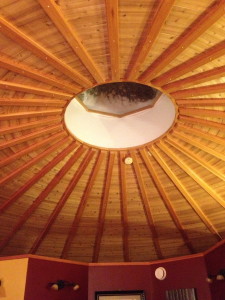 After a few rounds of conversation (too short, but all the time we had), they were invited to move into Presencing. “If it weren’t a cold winter night outside,” I said, “I’d encourage you to move outside for this part. Instead, find a quiet place inside where you can be alone with your thoughts and with whatever wants to emerge.” (As an aside, it felt beautifully appropriate that we were gathered inside a mandala home, a circular home built with great intention around honouring the four directions, giving space at the centre, and blending into the beauty of nature that surrounds it.)
After a few rounds of conversation (too short, but all the time we had), they were invited to move into Presencing. “If it weren’t a cold winter night outside,” I said, “I’d encourage you to move outside for this part. Instead, find a quiet place inside where you can be alone with your thoughts and with whatever wants to emerge.” (As an aside, it felt beautifully appropriate that we were gathered inside a mandala home, a circular home built with great intention around honouring the four directions, giving space at the centre, and blending into the beauty of nature that surrounds it.)
The next phase brought them back to the garbage on the floor, where they began to explore what wanted to emerge. Some felt stuck and really didn’t connect right away with the garbage on the floor. Others were eager to jump in and host the emerging future. Before long, though, everyone had made a valuable contribution to the scale model of the new community that wanted to be born.
We spread our community out on a large piece of cardboard on the table. Some pieces represented a connection with nature, others represented a connection with our neighbours, others represented a connection with opportunities/arts/beauty/etc., and still others represented a deeper connection with self and the sacred.
When we sat discussing the panorama in front of us, we realized that the resounding theme of what was emerging was connection. We were all longing for connection – with each other, with the earth, with the water, with the Sacred, and with ourselves.
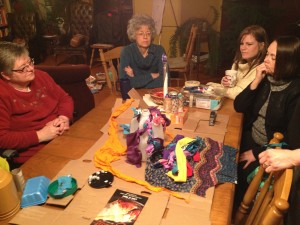 One woman asked “If recycling is the bi-product of a culture of consumption, what can replace consumption as our dominant paradigm that will no longer have a requirement for recycling?” Connection, we agreed. We need deeper connection.
One woman asked “If recycling is the bi-product of a culture of consumption, what can replace consumption as our dominant paradigm that will no longer have a requirement for recycling?” Connection, we agreed. We need deeper connection.
Before we departed for the night, I invited the women to consider (in their private moments, when they were back in their homes) “How might each of us be ambassadors for connection in our communities? How might we begin to invite this future into the circles in which we live?”
The women left with new lights in their eyes that hadn’t been there when they’d entered the room – all because of a pile of garbage and a time of connection.
(Next week’s session flows beautifully out of this… We’ll be talking about making connections in women’s leadership circles, using the new toolkit created by my teachers Christina Baldwin, Ann Linnea, and Margaret Wheatley.)
Note: If you want more inspiration on this, visit Presencing Institute, read Theory U, Presencing, or Walk Out Walk On.
by Heather Plett | Nov 13, 2012 | Uncategorized
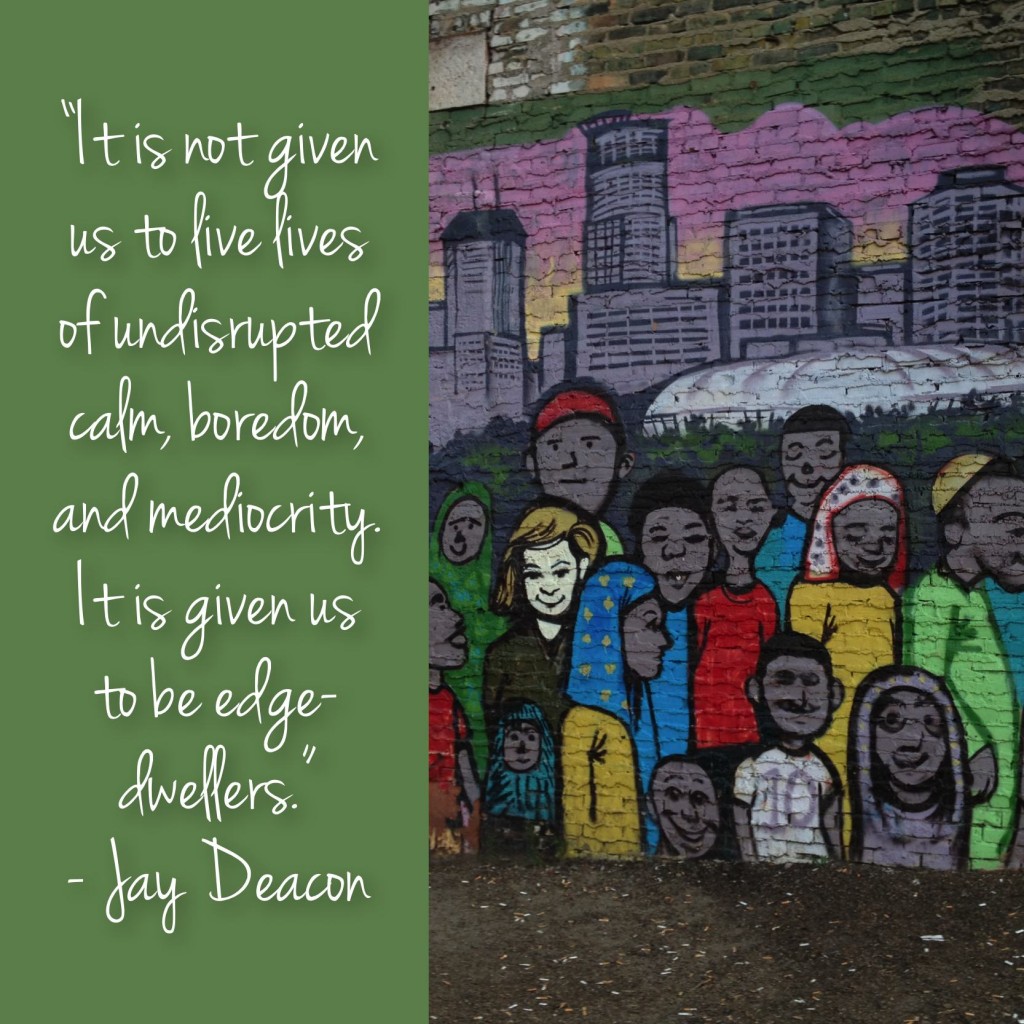
The more conversations I have in preparation for Lead with your Wild Heart, the more I am convinced that this work is not optional. This work is critical. This work is what we are all being called to in one way or another. The world needs us to accept the invitation into this work.
Leading with your wild heart is not about abandoning everything we know and moving into the woods. It’s about engaging with the world around us. It’s about sitting in deep conversations with our neighbours. It’s about seeking more authentic ways to live. It’s about having the courage to tell the truth.
Why is it important that people get in touch with and learn to lead with their wild/authentic/creative/expressive/vulnerable hearts?
I’ll let some of the members of my wisdom circle share their thoughts on this question:
Julie Daley: “Leadership is nothing without love, connection, and relationship. And where do we find love, connection, and relationship? The heart: through a wild and authentic heart that pulses and beats with the width and breadth of our humanity. It is in our full humanity that we find our way to true leadership, a leadership that invites others into their own wholeness and personal leadership.”
Filiz Telek: “Because the world calls for it right now! and our survival literally depends on it. The heart is the doorway to a wholesome, healthy, joyful, authentic life beyond right and wrong.”
Ronna Detrick: “My impulsive response to this is that you can’t lead if you’re not doing in with a wild/authentic/creative/expressive/vulnerable heart. My calmer response is to say that, of course, leading can take place, but I’d wonder if it’s really you that’s doing so if it’s in any form that’s not all that wildness and heartness. We are so enculturated to understand and recognize leadership in a particular way…andrarely with words like “wild” and “heart.” To get in touch with and lead from this place has the potential to change EVERYTHING!”
Lisa Wilson: “We’ve been asleep for far too long. We have reached a point in our collective evolution, a turning point, where the calls of something more can no longer be ignored. The wild heart of each individual, beating to a knowing that goes far beyond logical understanding, holds the paths to our healing. There is no one else who can heal you but you, and there is no other time to heal than now. The wild, creative heart longs to be heard, acknowledged, and to be the rhythm to which you take every step. There are many who still do not hear the calls; thus, those who can hear have a responsibility to guide themselves and others towards this awakening. It is time.”
Hali Karla: “Because the world needs it more than ever. The world is changing and our heart-wisdom is all too often left forgotten in our daily lives and how we interact with one another. In a world based on segmentation, we’ve nearly forgotten the primal power of true connection and devotion to our vulnerable selves and source. That is why people ache deep down for compassion, expression, soul-integration and belonging – and that is also exactly why change is coming. Because it is needed and desired, deeply. It is time to remember our inherent potential. Nature has this way of balancing itself out in the end. Regardless of how humans occupy themselves they are part of this amazing balance. Big changes and innovations, new paradigms of leadership and connection, and living in harmony with ourselves and our world will require adaptability, flexibility, deep self-awareness and radical empathy… this begins within, in the rivers where our own passions flow, uninhibited. And the more of us who choose to lead with the light from this intention, the more others will be inspired to step into that light and begin to explore the exponential beauty and transformation of heart-centered, sustainable, community-focused creative potential.”
Jodi Crane: “Because that’s where the joy is. That is using your creative gifts for good, being self-actualized, and living your full potential. Why would you not want to do that?”
Michele Lisenbury Christensen: “Our tendency – as pushed by both our brain structure and our culture – is to lead with our tough, logical, organized, methodical, clenchy, stiff-upper-lip selves. And all those qualities ARE valuable. Challenge is, we’ve got ’em in spades, and they crowd out the softer, wilder, more emotionally connected, more intuitive, more humane aspects of our power and our leadership. And when that happens, our capacity to respond effectively is dampened. We can’t, without our wild hearts, be present to our own emotions, our messy processes. We can’t be agile with the human process of coming with change. We can’t make difficult decisions that necessarily have downsides, and be present through the inevitable turbulence in their wake. We can’t be truly courageous without our vulnerability; we can only be brave. And that’s a pale substitute.”
Ann-Marie Boudreau: “That is where intuitive creation resides, where our own unique gifts are born and make their way into the world where they become a part of the process of evolution in moving all sentient and non-sentient beings forward on the path of life. It is in this place where we all dance together in community creating and shaping the world around us, unfolding our earth story before us with the dawn of each new day.”
By the way, my dear reader, YOU ARE IN MY WISDOM CIRCLE TOO! Join the conversation. Add your response to the question in the comments below. Why is this important?
Note: Registration for Lead with your Wild Heart is still open. You can download the first lesson free here. Join us in this exciting conversation about what can happen for the world if we step into our wild hearts.
by Heather Plett | Nov 5, 2012 | change, Community, Creativity, journey, Leadership, Passion
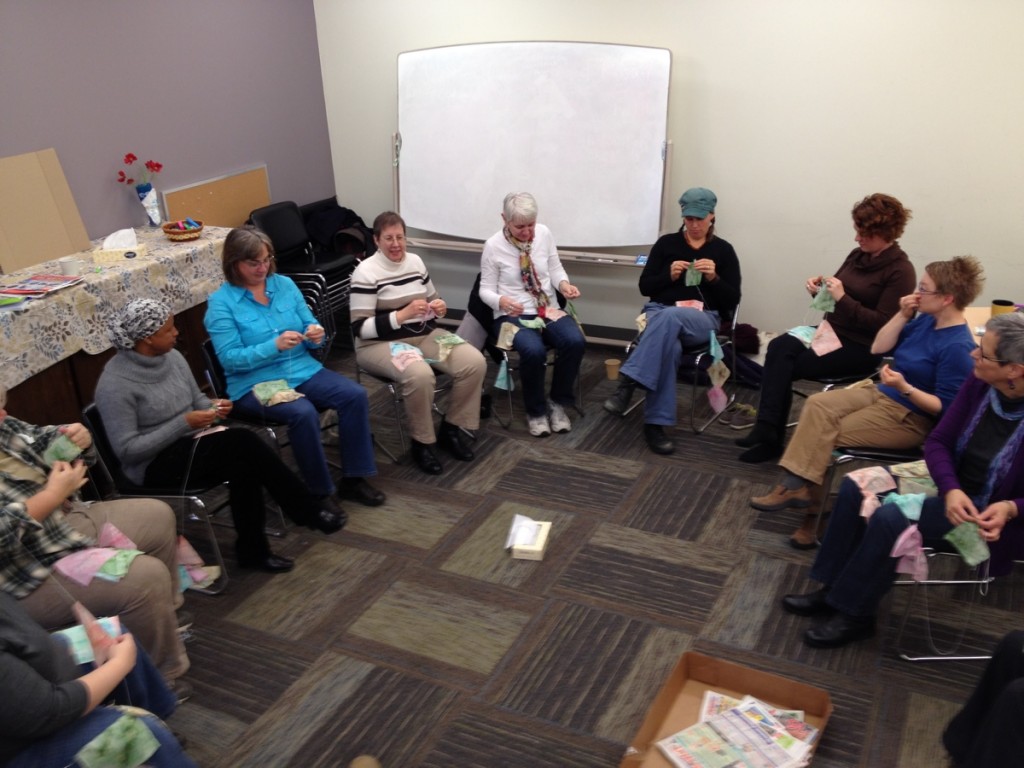
sharing stories and stitching prayer flags at a recent women's gathering
I talk a lot about stories – how important they are in helping us find collective healing, how transformative they can be in encouraging us to dream of a new world, how much they connect us to each other and give us courage.
“But what IS a story?” the students in my Creative Writing for Self-Discovery class pushed back a few weeks ago. “How do you define it? You’ve made reference to the story arc and conflict and plot, but we still don’t know the ‘rules’. How do we figure out whether or not something we write fits the definition of story?”
“Next week,” I promised, and then went home and started brushing up on my definition of story.
When I incorporate storytelling into leadership and personal growth workshops, I purposely leave my definition fairly vague. “A story is simply your account of how things happened. It can be as simple as helping people see a new possibility by telling them ‘when Jim did this last week, it made his daily routine much easier.'” But this was different. This was a group of creative writers who want to master the craft of writing short stories – whether simply for their own enjoyment or for the possibility of getting them published some day.
I did what any teacher would do – I went back to the tried and true definitions from back when I was getting my English degree. I typed up a lovely list of story elements for my students – setting, plot, conflict, character, point of view, and theme. I found a helpful diagram of the story arc that demonstrates how a story moves from routine, through the inciting incident that changes everything, through rising tension, to the climax, and ultimately to the denouement (resolution). I defined the protagonist as the main character and the antagonist as whatever source of conflict arises from the inciting incident which the protagonist must conquer before there is resolution. As I prepared my notes, I had flashbacks of my literature professors (all aging white men, incidentally) drilling it into our impressionable mines that “unless there is conflict and some kind of climax and resolution, THERE IS NO STORY!”
It was all good material that my professors would have been proud of… BUT… it didn’t entirely satisfy me. Something was wrong. Even though it was the kind of handout that would have gotten me an A in my university literature classes, the twenty plus years of wisdom I’ve gained since didn’t quite jive.
Then, while reading A Passion for Narrative, something jumped out and shook me out of my complacent regurgitation. You could say that it was my “inciting incident” where everything changed. It was this quote from Janet Burroway:
“Seeing the world in terms of enemies and warring factions not only limits the possibilities of literature, but also promulgates an aggressive and antagonistic view of our own lives. Further, the notion of resolution is untrue to life, and holds up perfection, unity, and singularity as goals at the expense of acceptance, nuance, and variety… Birth presents us with an alternative model in which there is a desired result, drama, struggle, and outcome. But it also represents a process in which the struggle, one toward life and growth, is natural. There is no enemy. The “resolution” suggests continuance rather than finality. It is persuasively argued that the story as power struggle offers a patriarchal view of the world, and that it would improve both stories and world if we would envision human beings as engaged in a struggle toward life.”
WAIT JUST ONE MINUTE! There’s a different way of defining stories? There doesn’t need to be a protagonist and an antagonist and the struggle doesn’t need to be AGAINST someone or something?
Something new in me woke up. Perhaps more truthfully, something old and primal in me was re-awakened. Suddenly it all made sense, and my storytelling wisdom lined up with my exploration of feminine wisdom.
We’ve been telling too many patriarchal stories! We’ve been letting our old white male university professors convince us that that’s the way it HAS to be! We’ve been conditioned to believe that our stories are not real stories unless there is an evil force to overcome. We’ve sat through hundreds of movies, read thousands of books, and listened to a million children’s stories that have all lead us to believe that there is conflict that needs to be overcome and that the only way to wrap up the story is to tie up the loose ends into some kind of (usually artificially constructed) resolution.
We don’t have to tell those kinds of stories anymore. In fact, the world needs us to start telling NEW stories – ones that are modelled on birth, where there is still a struggle, but this time we are struggling TOGETHER to bring about something new. There is no enemy. And the endings don’t need to be resolved, but rather they leave us at a place of continuance, growth, or just a whole lot of new questions for us to sit with.
This is so much bigger than simply a Tuesday evening creative writing class. This new way of engaging with story is about a new way of engaging with our economy, our religions, our communities, and our earth. It doesn’t have to be about competition anymore. There doesn’t have to be an antagonist in our stories. We can all be protagonists in the struggle together, birthing something new and ending not with a resolution, but with a step into the next story.
It all made sense to me when I read that quote, because THIS is what I feel most called to bring to the world – a new way of telling stories, a new way of walking through struggle, a new way of engaging with each other, and a new way of sensing the future. This is a new story that is actually more like an old story finally being reborn. Patriarchy does not have to rule us anymore. The old stories don’t have to control the way we see the world. We can usher in the Feminine. We can “shake the world with a new dream“. We can redefine ourselves as artists. We can build a new sacred economy. We can lead with our wild hearts.
It’s not easy letting go of the old stories. We’ll experience a lot of pain and resistance along the way. We’ll have to stand up to those wise old university professors and say “we respect your version, and it may have worked in the past, but we’ve got a new story to tell”. We’ll have to stand up to big business and say “you’ve created a lot of good products and you’ve allowed us to live in privilege, but it’s time to stop all this production and birth a new future.” We’ll have to challenge our governments and say “we’ve appreciated the way you’ve let us use our natural resources for our own ease and comfort, but it’s time to stop seeing Mother Earth as the antagonist in this story.” We’ll have to interrupt our meetings and public forums, move the chairs into circle, and say “thank you for leading us in the past, but we have a new way of gathering now and we believe it makes a difference when our chairs don’t mirror a hierarchical view of the world.”
This is what Lead with your Wild Heart is all about. I’ve gathered a Wisdom Circle of people who are willing to share the ways in which they’re learning to tell new stories, and together we’ll be “shaking the world with a new dream” – a dream where there are no enemies, we struggle together, and the end looks more like a set of new questions than a resolution.
I really hope you’ll join me and the other wise women who are starting to gather.
 What do a human rights lawyer in Zimbabwe, a psychologist who’s a wealth management specialist in Los Angeles, a former pastor training to be an art therapist in rural Manitoba, and a manager in an international tech company in Chicago have in common?
What do a human rights lawyer in Zimbabwe, a psychologist who’s a wealth management specialist in Los Angeles, a former pastor training to be an art therapist in rural Manitoba, and a manager in an international tech company in Chicago have in common? 





